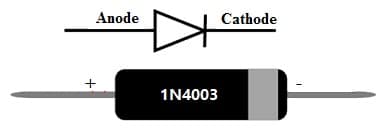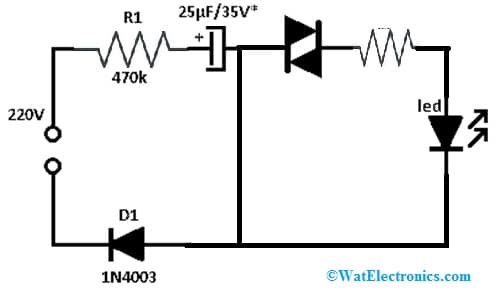A diode is a two-terminal essential electronic component used in many electrical and electronic circuits. The main function of a diode is to permit the flow of current in a single direction only from the anode to the cathode terminal. There are different types of diodes available in the market with different specifications. Among them, 1n400x series diodes are there which are known as rectifier diodes like 1N4001 to 1N4007. This article discusses one of the types of 1n400x series diode namely 1N4003 Diode – pin configuration, specifications, circuit, working, and its applications.
What is 1N4003 Diode?
The 1N4003 is a general-purpose rectifier diode manufactured by Fairchild used in DC input circuits for the protection of reverse voltage and also in DC-to-DC converters. This diode handles reverse voltage up to 200V & continuous current up to 1A. This diode is mainly designed for tolerating up to 30A of a voltage surge. Therefore, you use it in electronic circuits that can handle a power supply of less than 1A. Further, it has a negligible reverse current of 5uA.
Pin Configuration:
The pin configuration of the 1N4003 Diode is shown below with a symbol. This diode includes two pins anode and a cathode which are discussed below. In this diode, the cathode terminal is represented with a silver band.

1N4003 Diode Pin Configuration
- Pin-1 (Anode): The current flows through the anode terminal always.
- Pin-2 (Cathode): The flow of current exits the cathode terminal always.
Features & Specifications:
The 1n4003 rectifier diode’s fundamental features and specifications are given below.
- It is a silicon general-purpose rectifier diode.
- Junction Capacitance Typically is 15 pF.
- Its Weight is 0.33 grams.
- The type of Mounting is Through Hole.
- It has two terminals.
- It has a single configuration.
- The connection of the case is isolated.
- The material of the diode element is Silicon.
- It is ROHS3 Compliant.
- It is available in both SMD and DO-41 Packages.
- Its standard forward current – 1000mAor 1A.
- Its peak current is – 30Amps.
- Its reverse current is – 5uA.
- Its RMS reverse voltage – 140Volts
- Its peak repetitive reverse voltage maximum – 200V
- Its Power Dissipation is – 3W
- Maximum Storage and Operating range of Temperature is from -55 to +175 C.
220Volts LED Blinking Circuit
The circuit diagram of the 220V blinking LED is shown below. This circuit can be built with 220V mains supply, 1N4003 Diode, 470K, 25uF/35V, Diac, 680 ohms resistor & LED. The connections of this circuit follow as; the mains supply is connected to the 25uF/35V capacitor and 1N4003 Diode through an R1 resistor. The capacitor’s positive terminal is connected to DIAC whereas another terminal is connected to Diode. The DIAC is connected to the LED through a 680 ohms resistor.

220Volts LED Blinking Circuit
Working
This 220V LED blinking circuit is powered by a 220V mains supply. The mains voltage in the circuit charges the capacitor throughout resistor ‘R1’ & diode ‘D1’. When the voltage of the capacitor in the circuit doesn’t go beyond the switching voltage of DIAC then the capacitor will act as a blocked diode. After the switching voltage is reached, the DIAC will conduct & the discharging current of the capacitor lights up the LED. Here, the LED’s blinking frequency mainly depends on the RC time constant. So, the voltage of the capacitor should be a little bit high as compared to the break-over voltage of DIAC.
Equivalent & Alternative Diodes:
The equivalent 1N4003 diodes are; 1n4002, 1n4005, 1n4004, 1n4007, 1n4006, 1N4148, 1N4935, 1N4934, 1N5408, 1N4733A, 1N5822, RL202, SF12, RL203, HER103, HER102, FR203, HER203, FR202, HER202 whereas alternative IN4003 diodes are; 1n5408, 1N4148, 1n4733A, 1N5822, etc.
How to use 1N4003 Diode safely in a Circuit ?
To use the 1N4003 diode very safely in a circuit for a long time, it is recommended that the load should not drive above 200V and not drive the load above 1000mA. This diode must be used in temperatures between -55 oC to +175 oC always. Please refer to this link for Choosing resistor values for diodes.
Advantages
The advantages of the 1N4003 diode include the following.
- These are low cost.
- It is a reliable component to use in electronic circuits
- It has a high forward surge current ability.
- Low forward voltage drop and low reverse leakage.
- It is utilized for various general-purpose applications.
- This diode is assured with maximum soldering temperature.
- This diode has a better junction capacitance.
1N4003 Diode Applications
The applications of the 1N4003 diode include the following.
- 1N4003 diode is normally used in AC adapters as rectifiers.
- It is used in electrical appliances for changing alternating current to direct current.
- It is used in different power converters.
- It is used to protect circuits from inductive loads.
- These are used in AC adapters as current regulators for household appliances.
- These diodes are used in electronic devices for voltage boosting, voltage breakdowns & current rectification.
- These diodes help in preventing reverse polarity problems.
- These are used in different rectifiers like HWRs & FWRs.
- These are used as current flow regulators & protection devices.
- This diode is used to design a bridge rectifier that is used in a DC power supply.
- This diode is used in clippers-based applications and also to block reverse currents in various circuits for protecting different components.
- It is used in battery charger circuits, power supply rectifiers, ac to dc converters, inverters, adapter circuits, etc.
Please refer to this link for the 1N4003 Diode datasheet.
Thus, this is an overview of 1N4003 Diode – pinout, features, specifications, circuit, advantages, and applications. This is a reliable rectifier diode to use in various circuits especially useful for enthusiasts and hobbyists. Here is a question for you, what is the function of a diode?